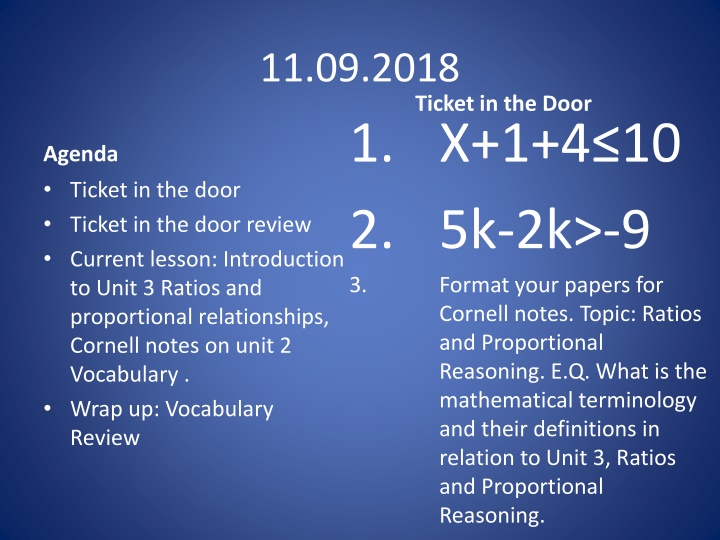
Proportional Relationships and Ratios: Understanding Mathematical Terminology
Explore the definitions and terminology related to ratios and proportional reasoning in Unit 3. Learn about unit rates, proportional relationships, and how to solve real-world problems using ratios. Essential questions guide your understanding of these mathematical concepts.
Download Presentation

Please find below an Image/Link to download the presentation.
The content on the website is provided AS IS for your information and personal use only. It may not be sold, licensed, or shared on other websites without obtaining consent from the author. If you encounter any issues during the download, it is possible that the publisher has removed the file from their server.
You are allowed to download the files provided on this website for personal or commercial use, subject to the condition that they are used lawfully. All files are the property of their respective owners.
The content on the website is provided AS IS for your information and personal use only. It may not be sold, licensed, or shared on other websites without obtaining consent from the author.
E N D
Presentation Transcript
11.09.2018 1. X+1+4 10 2. 5k-2k>-9 3. Format your papers for Cornell notes. Topic: Ratios and Proportional Reasoning. E.Q. What is the mathematical terminology and their definitions in relation to Unit 3, Ratios and Proportional Reasoning. Ticket in the Door Agenda Ticket in the door Ticket in the door review Current lesson: Introduction to Unit 3 Ratios and proportional relationships, Cornell notes on unit 2 Vocabulary . Wrap up: Vocabulary Review
Standards MCC7.RP.1 Compute unit rates associated with ratios of fractions, including ratios of lengths, areas and other quantities measured in like or different units. For example, if a person walks mile in each hour, compute the unit rate as the complex fraction ( ) miles per hour, equivalently 2 miles per hour.
Standards 7.RP Analyze proportional relationships and use them to solve real-world and mathematical problems. MGSE7.RP.1. Compute unit rates associated with ratios of fractions, including ratios of lengths, areas and other quantities measured in like or different units.Show details MGSE7.RP.2. Recognize and represent proportional relationships between quantities. MGSE7.RP.2a. Decide whether two quantities are in a proportional relationship, e.g., by testing for equivalent ratios in a table or graphing on a coordinate plane and observing whether the graph is a straight line through the origin.
Standards MGSE7.RP.2b. Identify the constant of proportionality (unit rate) in tables, graphs, equations, diagrams, and verbal descriptions of proportional relationships. MGSE7.RP.2c. Represent proportional relationships by equations. Show details MGSE7.RP.2d. Explain what a point (x, y) on the graph of a proportional relationship means in terms of the situation, with special attention to the points (0, 0) and (1, r) where r is the unit rate. MGSE7.RP.3. Use proportional relationships to solve multistep ratio and percent problems
Essential Questions What information do I get when I compare two numbers using a ratio? What kinds of problems can I solve by using ratios? How do I compute unit rate in tables, graphs, equations and diagrams? How do I compute unit rate in real-world problems? How do I use ratios and their relationships to solve real world problems? How do I recognize and represent proportional relationships between quantities?
Essential Questions How do I solve multistep ratio and percent problems using proportional relationships? How do I represent proportional relationships by equations? How do I solve problems involving scale drawings of geometric figures? How do I compute actual lengths and areas from a scale drawing? How do I reproduce a scale drawing at a different scale?
Vocabulary Fraction: A number expressed in the form a/b where a is a whole number and b is a positive whole number. Multiplicative inverse: Two numbers whose product = 1. Percent rate of change: A rate of change expressed as a percent. Example: if a population grows from 50 to 55 in a year, it grows by (5/50) = 10% per year.
Vocabulary Ratio: A comparison of two numbers using division. The ratio of a to b (where b 0) can be written as a to b, as a/b , or as a:b. Proportion: An equation stating that two ratios are equivalent. Scale factor: A ratio between two sets of measurements.
Vocabulary Rate of Change:
Vocabulary Similar Figures:
Vocabulary Equivalent Fractions
A number expressed in the form a/b where a is a whole number and b is a positive whole number.
Two numbers whose product = 1.
Multiplicative inverse
A rate of change expressed as a percent. Example: if a population grows from 50 to 55 in a year, it grows by (5/50) = 10% per year.
Percent rate of change
A comparison of two numbers using division. The ratio of a to b (where b 0) can be written as a to b, as a/b , or as a:b. Blue to Red
An equation stating that two ratios are equivalent.
A ratio between two sets of measurements.
Reference http://freedomms.dekalb.k12.ga.us/UNIT3Rat iosandProportionalRelationships.aspx
A number expressed in the form a/b where a is a whole number and b is a positive whole number.
Two numbers whose product = 1.
Multiplicative inverse
A rate of change expressed as a percent. Example: if a population grows from 50 to 55 in a year, it grows by (5/50) = 10% per year.
Percent rate of change
A comparison of two numbers using division. The ratio of a to b (where b 0) can be written as a to b, as a/b , or as a:b. Blue to Red
An equation stating that two ratios are equivalent.
A ratio between two sets of measurements.






















